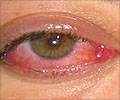The cornea is a transparent outer covering of the eye. When it starts thinning, it becomes a ticking bomb, a risk factor for blindness.

David Mackey, professor and head of opthalmology at University of Western Australia (UWA), said the finding was significant because a thin cornea was one of the risk factors for keratoconus as well as glaucoma, the second leading cause of blindness overall in Australia, the journal Nature Genetics reports.
Keratoconus is a thinning of the central zone of the cornea, causing the normally round shape of the cornea to become distorted and a cone-like bulge to develop, resulting in significant visual impairment, according to an UWA statement.
"Keratoconus is a leading cause of severe visual impairment in young adults and the main indication for corneal transplant in most developed countries, including Australia. A combination of these gene variants can result in a person having a thinner cornea and much greater risk of developing eye diseases," Mackey said.
Mackey said earlier, smaller studies had identified some genes for corneal thickness variation. The study combined data from 20,000 people in Australia, Europe, North America and Asia in the largest analysis to date.
"These findings allow researchers to now target specific gene pathways involving collagen to help prevent and treat keratoconus and glaucoma," Mackey said.
Advertisement











